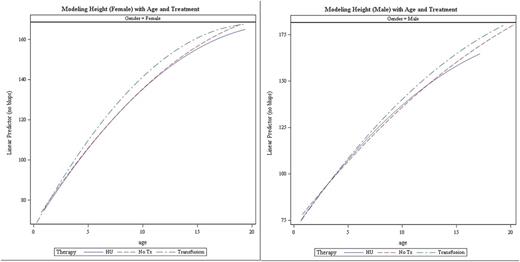Abstract
Background: Adolescent patients with Sickle Cell Anemia (SCA) may demonstrate impaired growth. To better understand the impact of transfusion, hydroxyurea, or no modifying therapy on growth, we retrospectively analyzed the growth patterns over 18 years for a large cohort of patients with HbSS or SB0 thalassemia.
Methods: We identified 454 subjects with HbSS or SB0 thalassemia in our practice. We recorded growth points (height, weight, body mass index (BMI)) along with white blood cell count, hemoglobin, and SCD modifying therapy from each annual sickle cell visit. For participants that were on transfusion therapy, we recorded the blood count immediately prior to a transfusion. We recorded therapy as the therapy utilized for the majority of visits during the last 12 months. The primary outcome for this project was growth pattern during puberty years. Therefore, we excluded younger participants (<age 8 (girls) or age 9 (boys) or older participants that lacked growth parameters obtained prior to age 8 (girls) or 9 (boys) (total excluded n=233). We analyzed 2119 growth records among the remaining 221 participants. For modeling height over time, we used linear mixed model for other variables with random intercept. This allows us to address the issue of the correlation among repeated measures from the same participant. We fitted the model with age, treatment group and age by treatment group interaction. Treatment effect was deemed significant if the interaction with age was significant. We fitted both linear and quadratic age effect and their interaction with treatment. If there was no evidence of a significant non-linear relationship, we simplified the model to linear age effect. We used a similar approach in modeling the effect of Weight, BMI, and hemoglobin on Height and Treatment.
Results: Female participants on chronic transfusion therapy were significantly taller than participants on hydroxyurea or no sickle cell modifying therapy (Figure, p<0.001). There was no significant difference in height over time between females that received hydroxyurea as compared with those that did not receive sickle cell modifying therapies. Male participants on transfusion therapy also were taller than patients who received hydroxyurea or no therapy. (Figure, p<0.001); however, no significant difference in height was observed between participants that were on no SCD modifying therapy as compared to hydroxyurea. Among female participants, we identified a positive relationship between height and hemoglobin level for participants on transfusion but a non-significant increase in height by increasing hemoglobin level for participants on hydroxyurea. Among males, all patients were taller based on hemoglobin level but no significant differences were detected between therapy and hemoglobin level. In analyzing weight for female participants, therapy had a significant impact on weight (p=0.006). Participants on transfusion therapy had increased weight as compared to participants on hydroxyurea or no sickle cell modifying therapy. In males, the overall model again identified therapy as significant for weight gain (p=0.01). Finally, BMI was significantly higher for females participants on transfusion than participants on hydroxyurea or no sickle cell modifying therapy (p=0.01) Among males participants, therapy had a significant impact on BMI (p=0.05) although hydroxyurea participants had the highest BMI.
Conclusion: Our data suggests that participants on transfusion therapy are generally taller compared to either hydroxyurea or no SCD modifying therapy. We also suggest that higher hemoglobin is associated with increased growth during pubertal years.
Lebensburger: ASH: Research Funding; NHLBI: Research Funding.
Author notes
Asterisk with author names denotes non-ASH members.


This feature is available to Subscribers Only
Sign In or Create an Account Close Modal